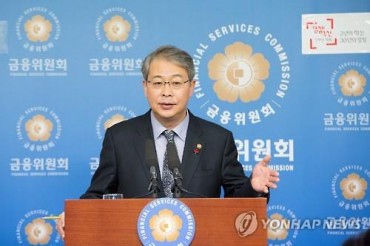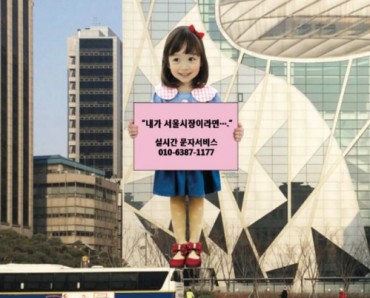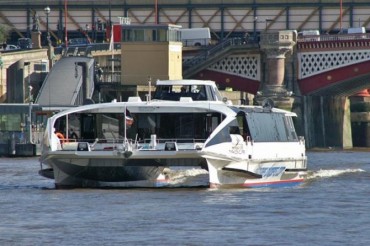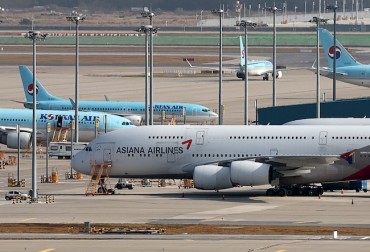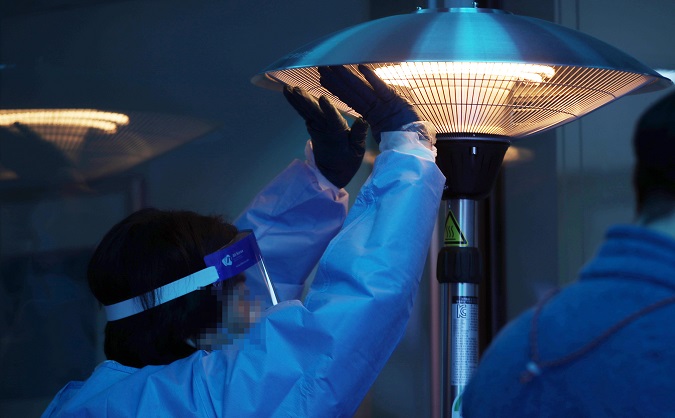
A health official working in an outdoor screening station at the National Medical Center in Seoul warms up next to a heating device on Nov. 4, 2020. (Yonhap)
SEOUL, Nov. 17 (Korea Bizwire) — The government decided Tuesday to raise the social distancing level by one notch to 1.5 in the greater Seoul area and Gwangju, amid a resurgence of new COVID-19 cases in the regions.
The measure will go into effect on Thursday in Seoul and Gyeonggi Province, while it will take effect from Monday in Incheon, given relatively less severe COVID-19 outbreaks in the city.
Incheon’s Ganghwa Island and Ongjin County will continue to remain under the Level 1 distancing.
Gwangju, southwest of Seoul, which reported 18 new cases Tuesday, the second-biggest single-day tally outside the capital region, also decided to enforce stricter rules starting Thursday.
The city logged a double-digit tally for the first time since Sept. 8, as clusters of infections have emerged at Chonnam National University Hospital and a local bar.
On Sunday, it tightened antivirus restrictions partly for high-risk business establishments in an effort to curb the spread of the virus.
“Antivirus efforts have faced a crisis,” Prime Minister Chung Sye-kyun said during a meeting of the Central Disaster and Safety Countermeasure Headquarters at the government complex in Seoul.
“Over the past week, the greater Seoul area had more than a hundred patients a day on average,” he said.
Chung attributed the move to the increasing number of elderly patients and a growing figure of transmission reproduction, which is currently at 1.15. The figure represents the number of people a patient is likely to infect.
The move came as South Korea’s coronavirus cases surpassed 200 for the fourth day in a row, with small pockets of infections and community transmission continuing to spread throughout the country.
Enforcing tighter rules is also aimed at suppressing the spread of the virus ahead of the national university entrance exam slated for Dec. 3, which 480,000 high school seniors and graduates will take.
The measure is partly to “create a safe testing environment for students,” Park Neunghoo, vice head 1 of the central countermeasure headquarters, said during a daily coronavirus briefing.
The College Scholastic Ability Test (CSAT) is the country’s biggest academic event of the year, and the whole country almost grinds to a halt for the smooth administration of the test.
Public institutions and the stock markets open an hour late to reduce traffic congestion so that students arrive at testing sites on time.
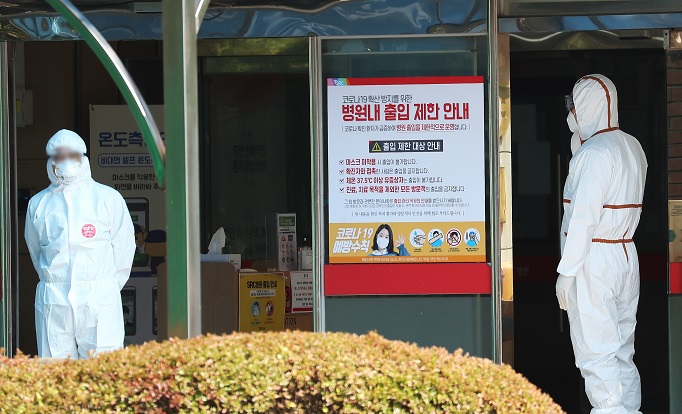
Wearing protective gear, quarantine officials stand in front of a rehabilitation hospital in Gwangju, just south of Seoul, on Oct. 17, 2020, where at least 32 COVID-19 cases were reported. (Yonhap)
Since Nov. 8, the country has reported more than 100 daily new infections. On Tuesday, it logged 230 new cases, including 137 in Seoul and adjacent cities, bringing the nation’s total caseload to 28,998 since the start of the pandemic.
With the absence of a single, large source of infection, new cases have been spotted at multiple locations and occasions, including an art club with 19 patients, a sports facility with 18 and a mountain trekking gathering with 14.
In the greater Seoul area, which includes the capital, Incheon and Gyeonggi Province, new cases have surpassed 100 for the fifth consecutive day.
According to data from the Korea Disease Control and Prevention Agency (KDCA), the capital area reported an average of 111.3 patients over the last week, and the number is 15.3 for Gangwon Province.
Authorities had mulled upping the alert level in Gangwon Province as well but stopped short of doing it.
The government said it will continue monitoring the pandemic situation there, but it will let the provincial government decide whether to enforce broad restrictions.
“When the level is raised, it will cause inconvenience to the public and bring hardship to small business owners, but we do know from prior experiences that a bigger crisis will come if we don’t act now,” Chung said, seeking understanding and cooperation from the public.
The country, which now operates a five-tier virus curbs system, has kept social distancing at Level 1 nationwide.
Under Level 1, people are required to follow basic guidelines, such as wearing masks, and gatherings of over 500 people are not recommended.
Under Level 1.5, the operation of multiuse and high-risk facilities will be restricted, and the attendance cap in schools is placed at two-thirds of the total student body.
The number of people allowed to assemble for religious and sports events is limited to 30 percent of full capacity.
(Yonhap)



